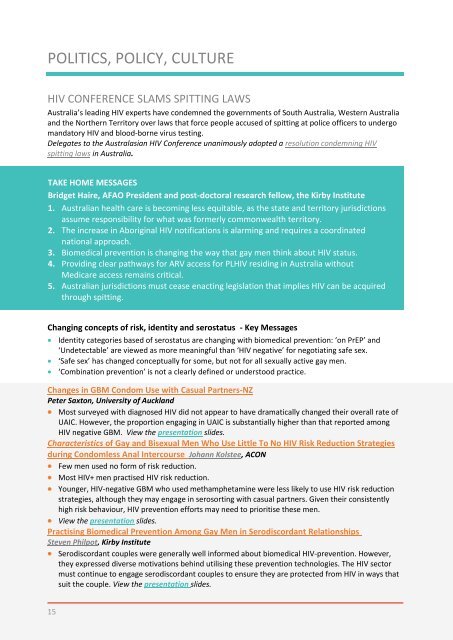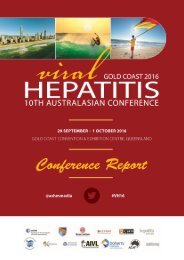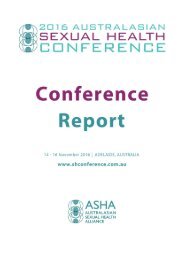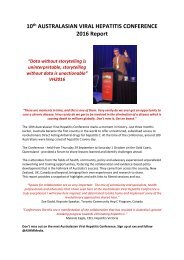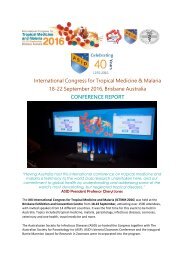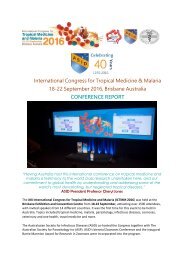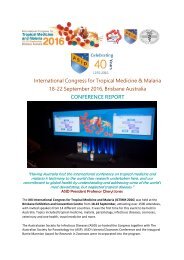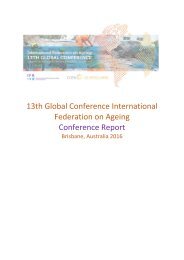AUSTRALASIAN HIV CONF REPORT 2016_FINAL
The Australasian HIV & AIDS Conference, run by ASHM, presents new and innovative research from across the Australasian HIV sector. Delegates include researchers, clinicians, policy makers, community organisations and activists. This 2016 Conference Report provides a collection of key learnings, with links to abstracts and presentations.
The Australasian HIV & AIDS Conference, run by ASHM, presents new and innovative research from across the Australasian HIV sector. Delegates include researchers, clinicians, policy makers, community organisations and activists. This 2016 Conference Report provides a collection of key learnings, with links to abstracts and presentations.
You also want an ePaper? Increase the reach of your titles
YUMPU automatically turns print PDFs into web optimized ePapers that Google loves.
POLITICS, POLICY, CULTURE<br />
<strong>HIV</strong> <strong>CONF</strong>ERENCE SLAMS SPITTING LAWS<br />
Australia’s leading <strong>HIV</strong> experts have condemned the governments of South Australia, Western Australia<br />
and the Northern Territory over laws that force people accused of spitting at police officers to undergo<br />
mandatory <strong>HIV</strong> and blood-borne virus testing.<br />
Delegates to the Australasian <strong>HIV</strong> Conference unanimously adopted a resolution condemning <strong>HIV</strong><br />
spitting laws in Australia.<br />
TAKE HOME MESSAGES<br />
Bridget Haire, AFAO President and post-doctoral research fellow, the Kirby Institute<br />
1. Australian health care is becoming less equitable, as the state and territory jurisdictions<br />
assume responsibility for what was formerly commonwealth territory.<br />
2. The increase in Aboriginal <strong>HIV</strong> notifications is alarming and requires a coordinated<br />
national approach.<br />
3. Biomedical prevention is changing the way that gay men think about <strong>HIV</strong> status.<br />
4. Providing clear pathways for ARV access for PL<strong>HIV</strong> residing in Australia without<br />
Medicare access remains critical.<br />
5. Australian jurisdictions must cease enacting legislation that implies <strong>HIV</strong> can be acquired<br />
through spitting.<br />
Changing concepts of risk, identity and serostatus - Key Messages<br />
Identity categories based of serostatus are changing with biomedical prevention: ‘on PrEP’ and<br />
‘Undetectable’ are viewed as more meaningful than ‘<strong>HIV</strong> negative’ for negotiating safe sex.<br />
‘Safe sex’ has changed conceptually for some, but not for all sexually active gay men.<br />
‘Combination prevention’ is not a clearly defined or understood practice.<br />
Changes in GBM Condom Use with Casual Partners-NZ<br />
Peter Saxton, University of Auckland<br />
Most surveyed with diagnosed <strong>HIV</strong> did not appear to have dramatically changed their overall rate of<br />
UAIC. However, the proportion engaging in UAIC is substantially higher than that reported among<br />
<strong>HIV</strong> negative GBM. View the presentation slides.<br />
Characteristics of Gay and Bisexual Men Who Use Little To No <strong>HIV</strong> Risk Reduction Strategies<br />
during Condomless Anal Intercourse Johann Kolstee, ACON<br />
Few men used no form of risk reduction.<br />
Most <strong>HIV</strong>+ men practised <strong>HIV</strong> risk reduction.<br />
Younger, <strong>HIV</strong>-negative GBM who used methamphetamine were less likely to use <strong>HIV</strong> risk reduction<br />
strategies, although they may engage in serosorting with casual partners. Given their consistently<br />
high risk behaviour, <strong>HIV</strong> prevention efforts may need to prioritise these men.<br />
View the presentation slides.<br />
Practising Biomedical Prevention Among Gay Men in Serodiscordant Relationships<br />
Steven Philpot, Kirby Institute<br />
Serodiscordant couples were generally well informed about biomedical <strong>HIV</strong>-prevention. However,<br />
they expressed diverse motivations behind utilising these prevention technologies. The <strong>HIV</strong> sector<br />
must continue to engage serodiscordant couples to ensure they are protected from <strong>HIV</strong> in ways that<br />
suit the couple. View the presentation slides.<br />
15


